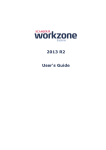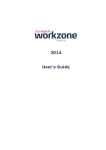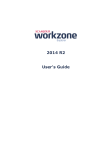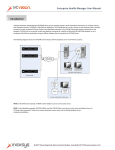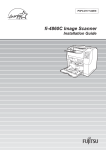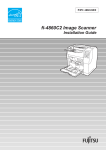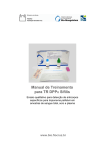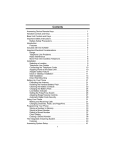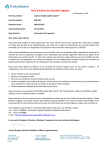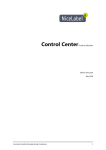Download WorkZone Explorer - User's Guide
Transcript
2013 SP1 User's Guide WorkZone Explorer 2013 SP1 Contents 2 User's Guide for WorkZone Explorer 2013 SP1 3 Revision history 4 Getting started 5 What's new 7 About the folder structure 8 Working with cases 11 About documents 12 Working with documents 15 Search for cases and documents 17 Optimizing performance and user experience 19 Advanced features and troubleshooting 21 FAQs 22 Terms and conditions 24 User's Guide User's Guide for WorkZone Explorer 2013 SP1 The purpose of this User's Guide is to describe how to use Microsoft Windows Explorer to manage documents in the ScanJour archive using WorkZone Explorer. The guide describes how the ScanJour model is mapped into a file system using a WebDAV model and how to handle cases and documents using Windows Explorer or a document editor, for example Microsoft Office and Notepad. LINKS WorkZone Services blog 3 WorkZone Explorer 2013 SP1 Revision history Version Comment 2013 A new section describing Draft Versioning has been added. See About doc- SP1 uments.htm. Description of the My list folder has been added to Folder types. See About the folder structure. Description of how to open a case in WorkZone Client from WorkZone Explorer. New topic describing how to work with cases. See Working with cases. New topic on how to perform free text searches on cases and documents. See Searches. New topic on how to optimize performance. See Optimize performance. The FAQ topic has been extended and now explains a number for error situations that you may run into. See FAQ. 4 User's Guide Getting started WorkZone Explorer uses WebDAV (Web Document Authoring and Versioning), which is a standard document protocol over HTTP. With WorkZone Explorer, you can manage cases and documents from Windows Explorer. You can perform common operations on cases and documents such as creating and renaming cases and documents, opening, editing, and saving documents directly into the ScanJour archive from a document editor that supports the WebDAV protocol, for example, Microsoft Office or Notepad. WorkZone Explorer is part of the WorkZone Content Server installation. Note that it is not required to install a client, such as WorkZone Client or Captia Web Client. GETTING ACCESS TO WORKZONE EXPLORER To start WorkZone Explorer, enter the following URL in your browser: http://[WebDAVHostHeader] WebDAVHostHeader is the host header that was specified during installation. When you enter this URL in a browser, you get this welcome screen: Click Browse using Windows Explorer to open Windows Explorer: 5 WorkZone Explorer 2013 SP1 In Windows Explorer, you can also open the WorkZone Explorer archive directly by typing \\ [WebDAVHostHeader]\DavWWWRoot in the address bar. You can also map a point in the folder structure to a network drive in Windows Explorer. Now you can double-click the database folder to display the standard lists that represents cases and documents. For more information see: About the folder structure Working with cases Working with documents See also Optimize performance for information on how to optimize the performance of WorkZone Explorer. 6 User's Guide What's new WorkZone Explorer 2013 SP1 contains the following new features: l The versioning part, DeltaV, of the WebDAV protocol is now supported by WorkZone Explorer. l New folder named My lists, which exposes searches defined and saved by the user from WorkZone Client or Captia Web Client. See Folder types. l New icon for read-only documents. Read-only documents used to be highlighted in blue. Now the icon indicates that the document is read-only. See Read-only documents. l Create new cases. See Working with cases. l Create child cases. See Working with cases. l Free text search on cases and documents. See Search for cases and documents. 7 WorkZone Explorer 2013 SP1 About the folder structure After installing and getting access to the WorkZone Explorer server, you can access the following folder structure in Windows Explorer. THE WORKZONE EXPLORER ROOT The root of the WorkZone Explorer contains the WorkZone Content Server databases that were configured during installation of the ScanJour web server. The databases are represented as folders. In the example, one database name DB01 has been defined, but you can define multiple databases. WORKZONE EXPLORER DATABASE FOLDERS If you open a database folder, the standard lists that represent either cases or documents are shown, for example,Drafts, Open Cases, and so on. In addition, there is a Recycle Bin list. 8 User's Guide FOLDER TYPES WorkZone Explorer folder types: l Document lists Folders that represent standard document lists, for example, the Documents list or Drafts list. l Case lists Folders that represent standard case lists, for example, the Open Cases list. Note: WorkZone Explorer displays parent cases in lists, whereas if you open a case list, for example the Open cases list, in WorkZone Client or Captia Web Client, all cases in the list are displayed. l Case folders Folders that represent specific cases in the database. A folder represents one case and contains all the documents of that case. It may also contain child cases. Note: Each case folder contains a shortcut to opening a case in WorkZone Client. Doubleclick the shortcut to open the case in WorkZone Client. l My lists This folder contains searches that the user has saved from WorkZone Client or Captia Web Client to the database. Sub folders in the My lists folder correspond to saved searches. l Unclassified cases This folder contains the cases owned by you (you are the case handler) and that have not yet been classified yet. An unclassified case is a case in the case class named SJ-TEMP. SJ-TEMP is the default case class used when creating cases from WorkZone Explorer.For more information, see Create case. 9 WorkZone Explorer 2013 SP1 l Recycle Bin The Recycle Bin contains documents that you have moved from other folders to this folder in order to delete them. The Recycle Bin folder contains a drop point named Restore that enables you to restore a deleted document from the Recycle Bin folder to the case it was originally saved to. For more information, see Delete and restore documents. Important: Due to performance reasons WorkZone Explorer only displays the 1000 most recent entries in a folder. The most recent entries are considered as the ones that have been modified most recently. For documents, it is related to the last document update and not the last change of the document meta data. For cases, it is the last meta data change on that case. 10 User's Guide Working with cases You can perform the following actions on cases in Windows Explorer. CREATE CASE You can create new cases in Windows Explorer by creating new folders in these folders: l Open cases l Unclassified cases l Case folders If you create a new folder in a case folder, the new case becomes a child case. When you create a new case through WorkZone Explorer, it is created automatically in a temporary class named SJ-TEMP. You can change the class and other required information later using WorkZone Client or Captia Web Client. Cases created in SJ-TEMP are automatically added to the Unclassified cases folder regardless of where they were created. Note: If your organization only use facets and not classes, you can configure WorkZone Explorer to add a specific class as the default class. This is done in the web.config file. For more information, see Configure file class for WorkZone Explorer in the WorkZone Content Server Installation Guide. Important: The create case functionality is not available by default. You must enable case creation on the SJ-TEMP class in WorkZone Configuration Management. CREATE CHILD CASES You can create child cases in Windows Explorer by moving a case folder to another case folder. The case folder that you move becomes a child case. RENAME CASES You can rename a case by renaming the case folder. 11 WorkZone Explorer 2013 SP1 About documents You can open and edit all documents from any type of folder provided that you have the corresponding application installed. Note that the same document may appear in several folders, for example, a draft document is located in both the Drafts folder and in the case folder where it belongs. You can open and edit the document from either location. The changes you make are reflected in both locations. If you open a document from the Recycle Bin, the documents open in read-only. The example below shows the documents on a specific case: Note: The WorkZone Explorer server does not expose records of state “O” as they represent metadata without a document, which is not relevant for WorkZone Explorer. READ-ONLY DOCUMENTS The icon indicates that a document is read-only and cannot be edited. Read-only documents are documents that have the states UL (Locked ), ARK (Archived) or AFS (Closed). Microsoft Office products recognize the state when opening a document and open it in read-only mode. Document state Possible actions UL (Locked) It is a read-only document. You can move and rename the document. ARK (Archived) or AFS (Closed) It is a read-only document. You can rename the document. It is possible to change a non-read-only document to read-only in the File Properties dialog box, which results in the document state changing to UL, a locked draft. You cannot remove the read-only attribute as the ScanJour system does not allow this. If you try to do it, the change will not have any effect. See also Document attributes and document states. 12 User's Guide CHECK-OUT Microsoft Office products automatically lock (check out in ScanJour products) editable documents when they are opened. This prevents two users from editing the same document at the same time or the same user from editing the same document from different folders at the same time. For example, Microsoft Office has a feature that notifies the second user who opens a document when the document becomes available for editing. Microsoft Office can also allow editing from both users at the same time and automatically merge the changes. This feature works automatically with WorkZone Explorer. The Microsoft Office dialog box shown when a second (or third) user opens a document that is already being edited by someone else: Note: Some documentation editors, for example Notepad, only locks (checks out) the document when saving, which means that the last edit is always applied. DOCUMENT IDENTIFIER All documents have a document identifier (Dxxxx) as part of the file name. DRAFT VERSIONING If draft versioning is enabled in WorkZone Configuration Management, new versions of a document are created automatically. Versioning applies to documents with the state UÅ (Draft) or UP (Personal draft). DOCUMENT ATTRIBUTES AND DOCUMENT STATES In the example below, the Attributes column is added to the folder view in Windows Explorer. In this column, you can see the different file attribute combinations that can be exposed from the system. 13 WorkZone Explorer 2013 SP1 Attribute Document state and possible actions A It is an editable document with the state UÅ (Draft) or UP (Personal draft). You can edit, move, rename, and change the document to read-only. RAO It is a read-only document with the state UL (Locked). You can move and rename the document. RO It is a read-only document with the state ARK (Archived) or AFS (Closed). You can rename the document. 14 User's Guide Working with documents You can perform the following actions on documents in Windows Explorer using WorkZone Explorer. CREATE NEW DOCUMENTS You can create new documents directly in Windows Explorer or by using the Save As dialog box from a document editor. You can only create new documents in folders that represent specific cases. You cannot create a new document directly in, for example, the Drafts folder, because the ScanJour system requires a case for placing the document correctly in the system. You can also create a new document by copying it from another location to a case folder. In this case, the read-only state of the document is kept in WorkZone Explorer. It will be created with the state UÅ (Draft) or UL (Locked) depending on the read-only file property of the new document. The document will be created with a minimal set of metadata, the title is taken from the file name, the state from the read-only attribute, and the record type used is N (Internal). The system automatically appends the (Dxxxxx) identifier when refreshing. You can open the document using either the file name supplied by the client (without the Dxxxxx identifier), as long as the document remains on the same case and is not further renamed, or using the full name (with the Dxxxx identifier). RENAME DOCUMENTS You can rename documents from Windows Explorer. The new name replaces the document title in the ScanJour system. The (Dxxxxx) identifier in Windows Explorer is automatically appended when refreshing. The (Dxxxxx) identifier does not become part of the document title in the ScanJour system and you do not have to keep the (Dxxxx) identifier in the new name, it will automatically be appended upon refresh. You can open the document with and without the (Dxxxxx) identifier in the file name. WORK WITH DOCUMENTS OFFLINE If you have taken a document offline, for example, copied it to the Windows Desktop or to a USB stick, you can copy it back into the WorkZone Explorer store. This means that the document is updated in the store provided that you have not changed the (Dxxxx) part of the file name. When copying it back, Windows Explorer displays a message asking if you want to replace the existing version, keep both, or cancel. All three options are supported for case folders. However, if you copy the document to a folder that represents a standard list, for example, the Drafts folder, only replace and cancel are supported. Note: If you save the document with a new name when working offline and then try to copy it back to the WorkZone Explorer database, a message displays asking you whether you want to replace the existing document or keep both versions. If you reply Replace, the document is copied back to the store but it keeps the original name. If you want to use a new name, you must rename it in Windows Explorer. MOVE DOCUMENTS You can move documents from one case to another provided that the state of the document in the ScanJour system allows it. You can move documents using drag and drop or cut and paste. 15 WorkZone Explorer 2013 SP1 COPY DOCUMENTS You can copy documents from one case to another case or even from one database another database.When you copy a document, a copy of the document is created but document meta data have new default values. This means, for example, if you copy a document with access codes, the copy gets the default access codes and not the access code of the original document. DELETE AND RESTORE DOCUMENTS It is not possible to delete documents directly from folders but you can move documents to the Recycle Bin and then delete the document from this folder. The Recycle Bin is personal, which means that you only see the documents that you have moved there. The Recycle Bin contains a Restore drop point. If you drag a document from the Recyle Bin to the Restore drop point, it will be moved back to the case folder where it was originally placed. It is also possible to restore a recycled document to another case by moving it from the Recycle Bin to that case folder. 16 User's Guide Search for cases and documents You can search for cases and documents directly from Windows Explorer. Before you can start performing searches you must enable it by creating a search connector for cases and a search connector for documents. ENABLE FREE TEXT SEARCH ON CASES AND DOCUMENTS 1. In Windows Explorer, double-click the Search Cases folder or the Search Documents folder. 2. In the Add Search Connector dialog box, click Add to add the WorkZone Cases and WorkZone Documents search connectors to Windows. A WorkZone Cases in [Database] search connector and a WorkZone Documents in [Database] search connector are added to the user's Searches and is also avail- 17 WorkZone Explorer 2013 SP1 able from Favorites. SEARCH FOR CASES AND DOCUMENTS 1. Double-click the WorkZone Cases or the WorkZone Documents search connector depending on what you want to search for. 2. Enter a search text in the Search field and press ENTER. The search result is listed below. Note: The search results displays maximum 1000 hits. The most recent cases and documents are shown in the search result. Example of a document search result: 3. Double-click the case or document to open it. Important: The search in WorkZone Explorer should not be confused with the free search in Windows Explorer, which searches in file names. 18 User's Guide Optimizing performance and user experience To ensure optimal performance and user experience of WorkZone Explorer, you must apply specific configurations to clients and/or to the network/domain issued by group policies. This topic describes the client setup to be performed to ensure optimal performance of the WebDAV protocol. LAN AUTOMATICALLY DETECT SETTINGS If browsing the WorkZone Explorer folders is slow, make sure that the Automatically detect settings check box in the Local Area Network (LAN) Settings dialog box is not selected on the client. To open this dialog box, in Internet Explorer click Tools > Internet options > Connections tab > LAN Settings. INTERNET SECURITY ZONES The WebDAV protocol is based on http and therefore the Internet Security zones applies to WorkZone Explorer. To ensure the best user experience and optimal performance, the WorkZone Explorer host name must be configured correctly in the Internet Security Zones. 1. In Internet Explorer, click Tools > Internet options > Security tab. 2. Add http(s)://webdavhost to either the Trusted sites zone or the Local intranet zone. The Local intranet zone must be selected to have automatic integrated user authentication performed by Windows without Log on dialog boxes. 3. Add file://webdavhost to the Trusted sites zone. If the file protocol is added to the Local intranet zone, searching using the search 19 WorkZone Explorer 2013 SP1 connectors perform slowly when showing the results. In some cases, you might receive a security warning when opening a document folder location from a search result or when moving documents from the Recycle Bin to the Restore drop point. If you want to avoid these security prompts make sure that Launching applications and unsafe files is allowed for the Trusted Sites zone. 20 User's Guide Advanced features and troubleshooting It is possible to make permanent links to any document or case in the archive. It is available through a hidden folder called ".archive". All you need to know is the DNS, the ID, the document extension, and then you can open any document using this http address: http://[WebDAVHostHeader]/[DSN]/.archive/WhateverYouWant (D[RecordKey]). [Extension]. This mechanism can also be used to generate permanent links to any document. You can also show cases through the .archive folder using: http://[WebDAVHostHeader]/[DSN]/.archive/WhatEverYouWant (C[FileKey]) VIEW ERROR MESSAGES FROM THE SCANJOUR SYSTEM Sometimes Windows Explorer does not show user friendly and descriptive error messages from the WebDAV server in case of errors or illegal operations. See FAQ. If you want to see the real error from the ScanJour system, you can use Fiddler on the client to see the actual response and error from the server. 21 WorkZone Explorer 2013 SP1 FAQs This section contains a list of frequently asked questions on WorkZone Explorer functionality. Click any question below to see the answer. Why unclear error messages? Sometimes Windows Explorer does not show user friendly and descriptive error messages from the WebDAV server. When you perform an illegal operation, for example, try to move an archived document to another case, you only see a general error message such as: Cannot read from source or disk. Some of the Windows error messages that you might run into are explained in the FAQ items below. Why do I get an error message when I try to add a document to the Drafts folder You can only create new documents in folders that represent specific cases. You cannot create a new document directly in the Drafts folder, because the ScanJour system requires a case for placing the document correctly in the system. If you to try add a document to the Drafts folder, you get the following Windows messages depending on where you try to add it from: A device attached to the system is not functioning. - or Can't read from the source file or disk. Why do I get an error message when I try to create a new case folder? WorkZone Explorer is not configured to allow creation of new cases. Case creation must be enabled on the SJ-TEMP class in the file class system. You apply this configuration using WorkZone Configuration Management. If you try to create a new case, you get the following Windows message: Unable to create the folder 'New folder' - File system error Why do I get an error message when I try to create a new case folder in the Cases currently placed with me folder? You cannot create new cases in this folder. You can create new cases in the Open cases, Unclassified cases folders, and in specific case folders. If you try to create a new case folder in a folder, which does not allow case creation, you get the following Windows error message: Unable to create the folder 'New folder' - File system error Why do I get an error message when I try to move a document from one folder to another? You are probably trying to: l Move a document from one standard list to another. l Move a document from a case folder to a standard list, for example to the Open cases folder. l Move a document to a closed case. l Move a document that is archived or closed. This is not possible. In these cases, you get the following Windows error message: Can't read from the source file or disc. 22 User's Guide Why are folders not deleted when they seem to be? It is not possible to delete folders using WorkZone Explorer although it may look so in Windows Explorer. If you try to delete an empty folder, it looks as if the folder was successfully deleted but if you press F5 to refresh, the folder reappears. If you try to delete a folder with content, nothing happens after you have confirmed the deletion. Windows Explorer does not display any error message in this case. Why do I get a strange error message when I try to rename a document? There are several renaming scenarios where you might get this Windows error message: Can't read from the source file or disk For example, if you try to: l Change the document ID (DXXX) in the document name. It is not possible to change the ID, only the document name can be changed. l Rename a document, which is saved on a closed case. This is not possible. l Rename a document in Windows Explorer but the document is opened in WorkZone Client or Captia Web Client. Why are documents are not shown in Windows Explorer after moving? When moving documents between folders in Windows Explorer, Windows Explorer might get confused by the ScanJour mechanism that allows the same document to be exposed in multiple folders, and moving a document to the Restore drop point actually moves the document somewhere else. It seems that Windows Explorer caches the information on the document location and refuses to open it from somewhere else even if it is shown in the new location after refreshing. Try again a bit later and this issue is resolved. 23 WorkZone Explorer 2013 SP1 Terms and conditions INTELLECTUAL PROPERTY RIGHTS This document is the property of ScanJour. The data contained herein, in whole or in part, may not be duplicated, used or disclosed outside the recipient for any purpose other than to conduct business and technical evaluation. This restriction does not limit the recipient’s right to use information contained in the data if it is obtained from another source without restriction. DISCLAIMER This document is intended for informational purposes only. Any information herein is believed to be reliable. However, ScanJour assumes no responsibility for the accuracy of the information. ScanJour reserves the right to change the document and the products described without notice. ScanJour and the authors disclaim any and all liabilities. ScanJour is a trademark used under license by ScanJour A/S. All other logos, trademarks and service marks are the property of the respective third parties. Copyright © ScanJour A/S 2013. All rights reserved. 24
























